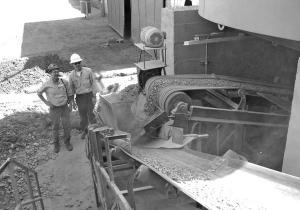A pilot mining program at the Bolivar mine in the Piedras Verdes mining district of Mexico’s Chihuahua state has generated operating cash for Dia Bras Exploration (DIB-V, DBEXF-o) since late 2005.
Now, a new resource estimate for the past-producing zinc-copper mine indicates the economics look sound enough to build a 500-tonne-per- day mill onsite rather than ship the ore, as it currently does, to its Malpaso mill, 250 km away.
In the measured and indicated categories, total undiluted resources have increased 26% to a total of 1.2 million tonnes grading 1.26% copper, 2.35% zinc, 0.28 gram gold and 30.7 grams silver per tonne.
In the inferred category, the resource has grown 55% to 6.3 million tonnes at 1.18% copper, 0.99% zinc, 0.3 gram gold and 26.4 grams silver.
The resources were calculated using a 2.5% copper-equivalent cutoff for the Upper Skarn and 1% copper- equivalent for the Lower Skarn and other zones.
In 2004, Dia Bras acquired an option on the Bolivar mine, 250 km southwest of the state capital Chihuahua city, for US$1.2 million, free of royalties from private owners. The mine was fully permitted, but had not operated for more than five years.
“The property presented a rare opportunity for near-term production from high-grade ore,” the company said in a press release.
Dia Bras started work on a prefeasibility study, including a pilot-mining program, in early 2005.
Using the production costs as determined by Dia Bras for underground mining at Bolivar, SGS Geostat determined that the costs were similar to other similarly sized copper- zinc operations in Mexico.
The cutoff grades were based on metal price assumptions of US$2 per lb. copper, US$1 per lb. zinc, US$10 per oz. silver and US$500 per oz. gold.
So far, Dia Bras has mined 99,202 tonnes of rock and shipped it to the Malpaso mill for processing.
In the meantime, Dia Bras continues to extend known zones of copper, zinc, silver and gold mineralization along the strikes of the Fernandez trend and the Rosario- Rodolfo trend, near the Bolivar mine, as well as in other areas of the property, which encompasses 75 sq. km.
In addition to Bolivar, Dia Bras acquired the 75 sq. km Cusihuiriachic (Cusi) silver district in the central western part of Chihuahua state, about 125 km west of the city of Chihuahua. Among its properties are 12 former mines that historically produced high-grade silver and are about 40 km away from the company’s Malpaso mill.
The structures at Cusi were mined as far back as 300 years ago, but have been untouched since the 1930s. Between 1927 and 1932 alone, the Cusi Mining Co. mined at least 8.5 million oz. silver from its five small underground mines there. Few of the mines were extended into the sulphide zones, however, because the company lacked the infrastructure, technology and expertise.
In Toronto, Dia Bras recently traded at about 10 a share in a 52-week range of 4-90. The junior explorer has 111.5 million shares outstanding.


Be the first to comment on "Dia Bras Plans Mill At Bolivar"